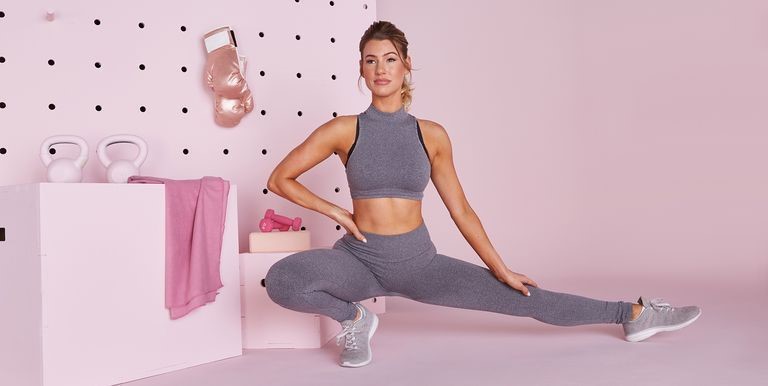
Best Ab Exercises
Today I am going to show you my best exercises for the core muscles. They are most definitely not what you think.
I am not going to do a single sit-up and I am not going to do a single crunch. Instead, I am going to teach you about 5 exercises that keep your spine in a neutral position and focus on stability and not dynamic movement through the spine.
That is one of the secrets to abdominal training at least initially. You have to develop a strong core via stability based exercises; working on the deeper core muscles. Once you are strong enough in your core, you can adopt more dynamic exercises down the road. But dynamic exercises do not help you get that defined abdominal look. It is all about full body workouts and I am going to show you 5 of them right now.
1. Kettle Bell Front Squat. You can use dumbbells or a barbell if they are everything you have. Hold the kettle bell at chest level, keeping the weight firm in your palms and not resting on your chest. Sink down into a squat and come back up. You may be wondering what a front squat has to do with abdominals; it has everything to do with abdominals – especially if you do this exercise with a barbell. When you have the barbell across the shoulders and sit up nice and tall, the mechanics of the squat movement forces massive core integration. The core is everything from the shoulders to the knees. Any muscle that crosses the shoulder girdle and the pelvis stabilizes the spine. This means that the front squat, even more that the back squat, gets the core involved.
2. Overhead Lunge. You may use a dumbbells or a barbell for this exercise. Pick up the kettle bell in your right hand and extend it over your head. Lunge forward with your right leg. This is a very challenging exercise for both your core and your arm. When you finish on the right side, switch arms and legs. Your shoulder and your tricep have to force that weight up and that movement integrates with your stabilizing muscles through your shoulder which integrates through your core. After just a few reps you will start to huff and puff.
3. Side Plank. You have probably done this before. Come up onto your forearm and feet. You will feel all the action in the ribs closest to the floor. Make sure that your spine is static and neutral and that you are focusing on stability. You are building up your external and internal obliques, and your quadratus lumborum which is a deeper internal stabilizing muscle. Just hold the pose. Repeat on the other side. If you are a beginner you can start from the knees.
4. Dead Bug. You will need a stability ball for this exercise. Lie on your back and place the ball between your arms and thighs like you are sitting on a chair. Extend your opposite arm and leg away from the ball and keep your spine neutral. Squish the ball between the arm and leg that are holding the ball in place. Alternate arms and legs every few seconds. This is an amazing exercise because
we are focusing on stability as we lengthen from the midsection. As you lengthen your arm and your leg away from your midsection, that increases the challenge of this exercise.
5. Ball Roll Out/Plank Roll Out. Position yourself on a stability ball like you are planking on the ball. Place your palms together. The key with the plank is that you perform a slight pelvic tilt so there is no arch in the back. Roll the ball out and pull it back in repeatedly with your arms.
As you lengthen your arm and your leg away from your midsection in the Dead Bug Exercise, the exercise becomes more challenging. The same thing occurs during the Ball Roll-out as you roll the ball away from your core. Those exercises are based on something in biomechanics called Moment Arm.
The further you move your weight away from its point of rotation, the greater the Moment Arm. To understand the Moment Arm better, think of lifting a barbell with your arm extended versus lifting the same barbell with your arm closer to your body. In the first scenario, there will be a lot of stress on your spine. In the second scenario, the stress is greatly reduced.
Moment Arm is the same reason why doing leg lifts with straight legs is more difficult than with your knees brought in. The Moment Arm is longer when your legs are extended because there is more weight that needs to be moved. Moment Arms put a lot of stress on the back if you are not in the proper position. Your goal with these exercises is to execute them safely by focusing on stability first. That means not flexing, twisting, or doing any abdominal crunching.
Your focus is on building stability in the core by performing static exercises that contract and stabilize muscles. Think of the overhead lunge when your arm is over your head. The same goes for overhead squats. Olympic lifters doing overhead squats drop down with the barbell above their head. The same thing applies there. There is a huge amount of core activation because all the muscles are supporting the weight indirectly through the shoulder.
You have to start moving away from sit-ups and abdominal crunches first of all because they do nothing in terms of burning calories. Second, those movements only work the rectus abdominis muscles; the six-pack muscles.
We want to work the entire core from the shoulder to the knees; the obliques, the extensors, the lower back, etc. There are many muscles that you have to work. You must do exercises that integrate the entire body and that focus on stability first. When you have a stronger core we can move into more dynamic movements.
If you are just starting out you must focus on stability first. Some of these exercises are a bit more advanced, so if you are a beginner make sure you check out the lesson that covers abdominal exercises for beginners. And remember, if you want to see your abs, you have to do full-body exercises and work very hard to burn more calories than you are taking in.
Author Bio:-
Ajay Dalal is a content writer and a copywriter who specializes in writing marketing blog Technology and sales pages. He often writes for Digital Junkies and Dricki.com and explores new technologies, and shares his knowledge through writing.


